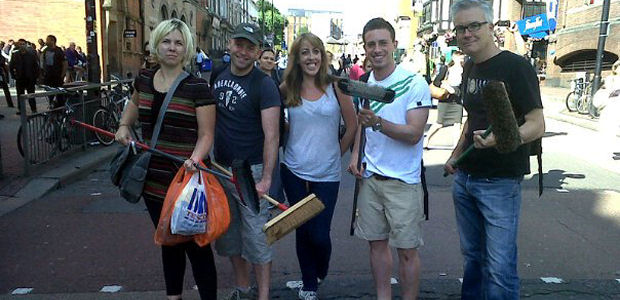How riot recovery brought communities together
The riots that spread across England in 2011 lasted a few days but some communities suffered lasting damage. However, the resulting clean-up fostered a community spirit that is still present now.

On 9 August 2011 communities across London began the task of repairing the damage of the previous days of rioting.
Gradually, with the help of social media and other informal networks, people came together with brushes and rubber gloves, rallied by the Twitter hashtag #riotcleanup.
One of the original and highest profile #riotcleanup efforts was at Clapham Junction. One of the organisers, Heather Taylor (left), said she felt much more part of the community as a result.
“I was there for six years,” she said. “Clapham Junction was my community and I was enraged that someone could do this to it.”
But the clean-up was so successful that participants soon started to realise that they could harness that energy and collective will power to fulfil more lasting aspirations.
Ms Tayor says that just days after the clean-up, an opportunity presented itself. A local housing estate was looking for extra pairs of hands to work in its community garden.
Long-term projects
Those involved in the clean-up, and willing volunteers who had not been available on the day, were drafted into help out and many continue to work on Doddington Community Garden.
It is local people saying ‘we need to fix this. We need to work together. Dan Thompson
“People realised that there are a lot more things happening in the community and that there are people just like them who want to help,” explains Ms Taylor.
Dan Thompson, who started #riotcleanup nationally, said the clean-up encouraged a sense that people wanted to participate in their community more.
He has since worked to capture that enthusiasm with long-term projects. One, called Retail Ready People, supports young, unemployed young people in setting up “Pop Up shops”.
Powered by Twitter
The second, We Will Gather lets you start a positive project in your community and find people to help complete it. The online tool is powered by Twitter.
Mr Thompson said that he got to know the people he is working with on We Will Gather through #riotcleanup.
The events that led to the riots took place in Tottenham, and the north London community was one of the worst hit.
Coincidently, at the time of the riots Tottenham was weeks away from having a business ambassador provided through the charity Business in the Community.
Kay Horne, who was seconded from Sainsbury’s to encourage local businesses to contribute to local good causes, said she had to rethink the type of firms that she targeted because so many of the smaller ones were badly hit by the riots.

Removing barriers
But she found that bigger companies, including her own, were willing to step into the breach and help out with community projects while the smaller firms were getting back on their feet.
She said the shops that were hit by the riots turned to their immediate community for help and found local people willing to support them. One firm responded by offering work experience for young people.
Ms Horne said recovering from the riots created a much stronger unity in the community than had been there before. “The only thing I could liken to it is the Second World War,” she said. “People clearing up their shops may have worked alongside each other for years but never spoken. Barriers have been broken down.”
She described how a black community group was using a Kurdish community centre because their base was riot affected.
“People have formed new relationships,” she said. “People really want this place to succeed and that willpower is there. If you harness it the only way is up.”
Some community workers have found that their work has taken on a new resonance as a result of the riots and found new supporters.
Barry Mizen, whose son Jimmy was a victim of a violent assault in 2008, has joined forces with parents of other murdered teenagers to make London a safer place.
One project he has been involved in is encouraging local businesses and organisations to offer their premises as CitySafe Havens to young people who are at risk of harm and making them pledge to report 100 per cent of crime
Community-led response
He is pleased that the project, which is run by London Citizens, has been backed by more than 200 business including House of Reeves, the Croydon furniture showroom gutted during the riots.
He is also heartened by the community-led response he has seen to the riots in the Lewisham area of south east London. “All of us are creating a better, less confrontational lifestyle, where everything doesn’t have to cause an argument.”
Like Mr Mizen, Dan Thompson is encouraged by how the response to the riots has been very grassroots led. “For me it is the fact it is not big, it is local people saying ‘We need to fix this. We need to work together’.”
But while the benefits coming out of the clean-up campaign are clear to see, those involved in the affected communities’ recovery are categorical that the riots, which killed five people across England, were a heavy price to pay for such initiative.
Ms Horne said: “I’d hate to say that the riots have helped anything because they haven’t and I would not want them to be repeated. But there were an awful lot of meetings and work that’s been done, which has turned into people power.”
For Mr Mizen, the riots emphasis the importance of tackling crime and making London a safer place, particularly for young people.
“There are still underlying issues that haven’t gone away,” he said. “But the work we are doing to respond to those issues have taken on a new kind of significance following the riots.”